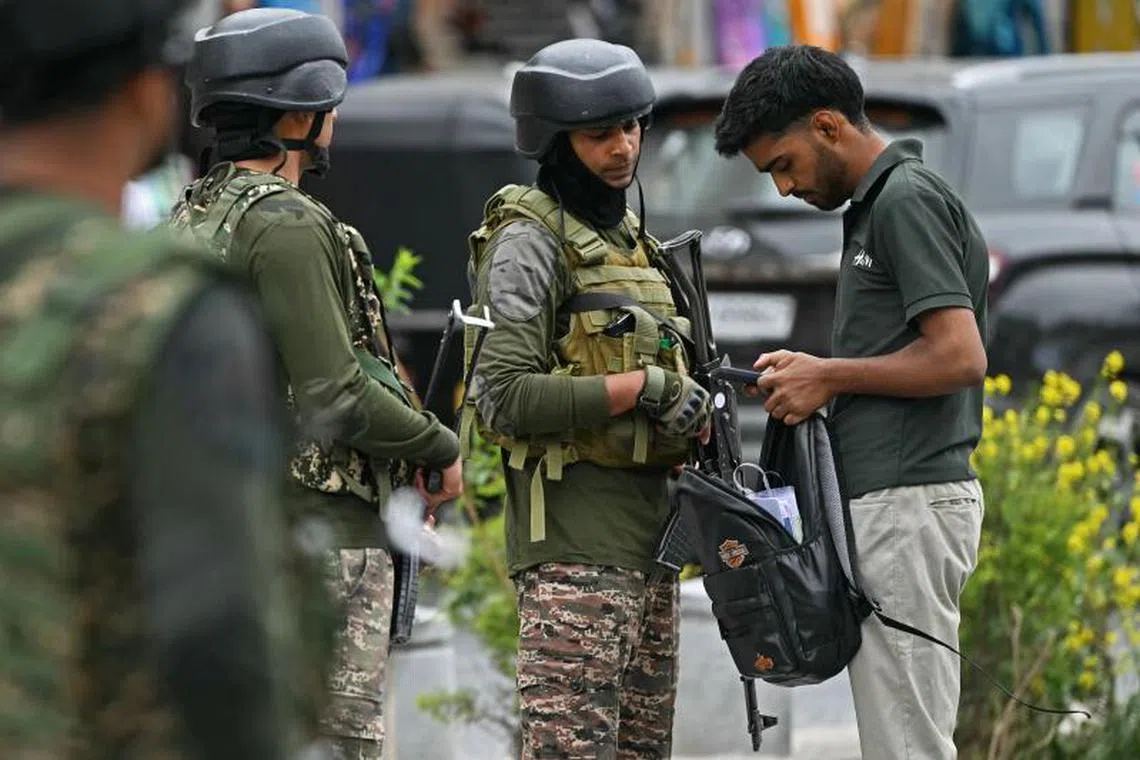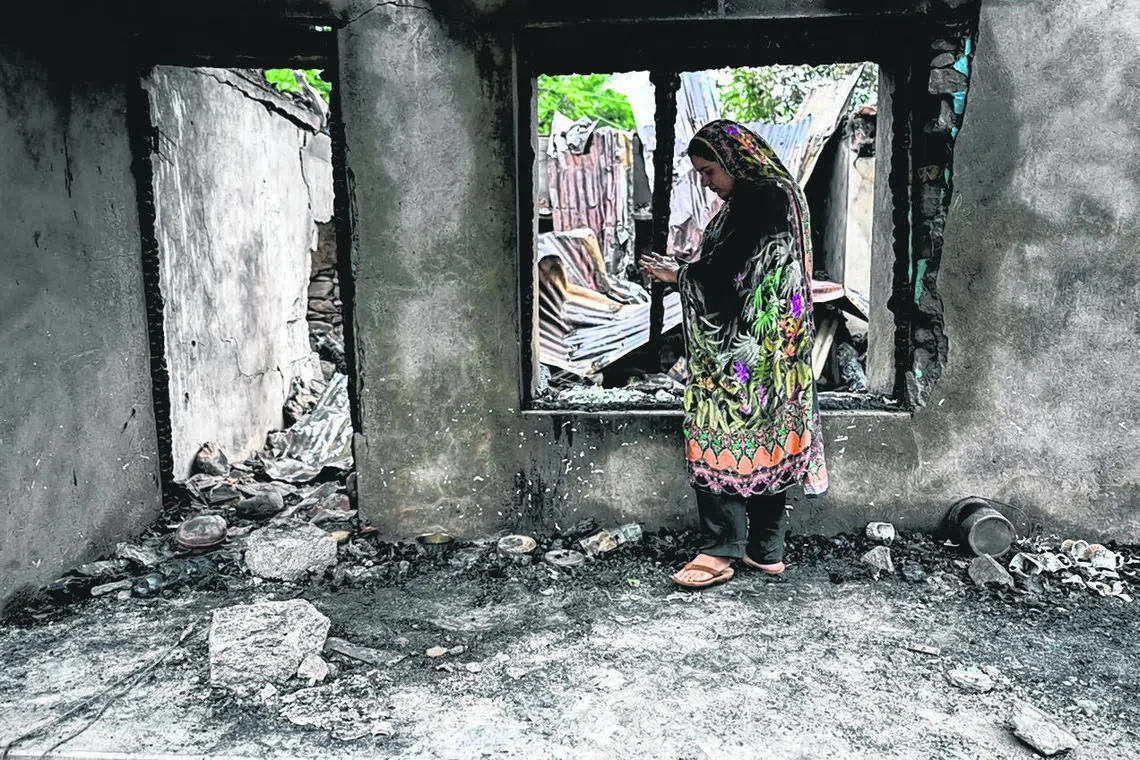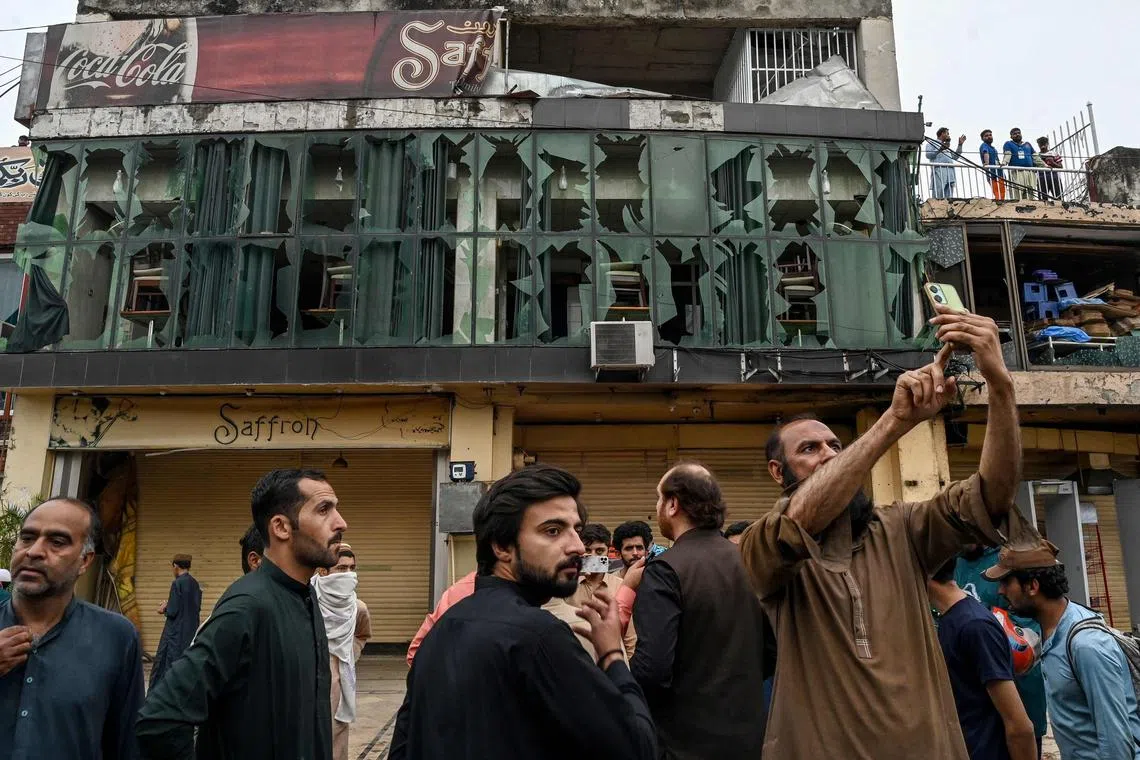News analysis
‘None of our business’: Is the US washing its hands of the India-Pakistan conflict?
Sign up now: Get ST's newsletters delivered to your inbox

Indian paramilitary soldiers check the bag of a Kashmiri man at a marketplace in Srinagar on May 9.
PHOTO: AFP
Follow topic:
WASHINGTON - The Trump administration’s isolationist, America First stance is showing in its surprisingly low-key response to the escalation in hostilities between nuclear-armed India and Pakistan after a terrorist attack in the disputed Kashmir region.
Coming while the White House is simultaneously making efforts to end the wars in Ukraine and Gaza, it perhaps reflects the superpower’s reluctance to play the policeman of the world.
India and Pakistan – which have fought three wars over Kashmir,
On May 9, Pakistan said it had shot down 25 Indian drones over the skies of its major cities like Karachi, Lahore and Rawalpindi. India said it had neutralised several Pakistani air defence radars and systems, including one in Lahore, after several cities in its border areas faced a barrage of missiles and drones.
Pakistan says Indian air strikes and cross-border fire have killed 36 people, while India has reported at least 16 dead from Pakistani shelling.
US President Donald Trump was noncommittal when asked about India’s May 6 air strikes on “terror infrastructure”
“I just hope it ends very quickly,” he said in response to the strikes which New Delhi said were in retaliation for the April 22 killings in Indian Kashmir of 26 tourists,
“I know both very well, and I want to see them work it out,” Mr Trump said the next day as Pakistan began shelling across the de facto border with India.
“They’ve gone tit-for-tat. So hopefully they can stop now. If I can do anything to help, I will be there.”
Likewise, Vice-President J.D. Vance, who was in India for an official visit when the tourists were attacked, said the US would not intervene in the conflict.
“We’re not going to get involved in the middle of (an India-Pakistan) war that’s fundamentally none of our business,” he told Fox News in an interview on May 8.
Though there has been a hint that the US has hardened its position against Pakistan, there are no signs it will change its hands-off policy.
State Department spokesperson Tammy Bruce, when asked at a press briefing on May 8 if Pakistan was supporting terrorist groups, answered in the affirmative.
“That’s a call that we have been making for decades,” she said. “It is the dynamic that we’ve seen in the Middle East, disrupting lives.”
This was also another divergence from traditional policy in the imbroglio in the subcontinent: the willingness to equate it with the situation in the Middle East, one of the most volatile hot spots in the world.
Ms Bruce said the violence should stop because that had not produced a solution either in the Indian subcontinent or in the Middle East.
“There has to be a change in that regard... new ideas to stop generational violence,” she said.

A woman stands outside her house destroyed by Pakistani artillery shelling at the Salamabad village in Uri, about 110kms from Srinagar, on May 8.
PHOTO: AFP
Meanwhile, her boss, Secretary of State Marco Rubio, pressed the point in separate calls to the leaders of India and Pakistan on May 8.
Mr Rubio, who has also taken on the role of national security adviser, is in some ways the most experienced face of the Trump administration owing to his tenure in the Senate intelligence and foreign relations committees. He has stressed the need for immediate de-escalation and direct dialogue between India and Pakistan.
The readout of the call to Pakistan Prime Minister Shehbaz Sharif said that Mr Rubio “reiterated” that Pakistan should take concrete steps to end support for terrorist groups.
In his call with India’s External Affairs Minister S. Jaishankar, Mr Rubio reaffirmed America’s commitment to work with New Delhi “in the fight against terrorism”.
The conservative view in Washington pins the blame on Pakistan for the presence of terrorist groups on its soil.
“Either these groups are acting on behalf of the Pakistani state, in which case Islamabad is directly responsible for their actions,” wrote Mr Jeff Smith, director of the Asian Studies Centre at the right-leaning Heritage Foundation, which has close ties with the administration.
“Or they are rogue actors (which no one believes), and the Pakistani state is still responsible for policing its borders and ensuring its territory isn’t being used to launch attacks on other countries,” he wrote in a post on X on May 7.
US-based analysts believe that the current tensions will ease before long.
“I believe Pakistan will be compelled to strike back at India,” said Mr Richard Rossow, senior adviser and chair on India and emerging Asia economics at the Centre for Strategic and International Studies (CSIS).
“If they initiate a small, unimportant strike in Jammu and Kashmir, it could begin de-escalation. But if they hit meaningful civilian or military targets and strike farther into India, India will need to counter-attack,” Mr Rossow said.
India and Pakistan have seen such cycles of violence before
“There is a possibility Pakistan may send some missiles or strike inside India for one final round, in which case India will say its air defence have struck those down. That gives both sides enough to satisfy their domestic opinions,” she said.
“India’s desire is that the global community understands that Indian victims of terrorism deserve as much sympathy as Western victims of terrorism. And that there should be global pressure on Pakistan, which has allowed in terror proxies since the 1990s.
“But most of all, India needs to tell its people that it has punished the perpetrator of the attacks on tourists.”
She said the Pakistani government, which has been under pressure from restive politics and a struggling economy, likewise needed to tell its people that Pakistan had been able to stand up to an Indian attack.
“So both sides have an off-ramp. I do think it will take about 24 to 48 hours for that to happen. I’m not one of those who believes this is going to escalate into war, let alone a nuclear war,” Dr Pande said.
Still, this is the closest the two sides have come to a direct conflict in recent years.
During a serious escalation in the past, then US President Bill Clinton intervened forcefully in the Kargil conflict in 1999 to prevent a broader spill-off between the two nations, which had then recently conducted nuclear tests.

People gathering in front of a damaged restaurant outside the Rawalpindi cricket stadium in Pakistan's Punjab province after an alleged drone was shot down on May 8.
PHOTO: AFP
While US attempts to broker peace are absent this time, previous administrations have been comfortable with limited Indian counter-attacks in 2016 and 2019 when India made cross-border strikes, said CSIS’s Mr Rossow.
“At the same time, the US administration is working hard to further accelerate the growing US-India partnership, and having India bogged down in a regional conflict with a far weaker nation can decelerate US-India ties,” he added.
And apart from the US abhorrence of terrorism, reasons to support India have only proliferated in recent years.
There is a clear tilt towards India over the past decade, agreed Mr Josh Kurlantzick, senior fellow for South-east Asia and South Asia at the Council on Foreign Relations.
Mr Trump’s personal relationship with Indian Prime Minister Narendra Modi is also a factor, according to Mr Kurlantzick. “The fact that Pakistan is so close to China does not help either,” he added.
Washington’s geopolitical rival China is Pakistan’s most important strategic and economic partner, and has replaced the US as the top source for its military equipment.
For the US, the reasons for building a relationship with India go well beyond a shared concern about China’s increasing belligerence.
India is about to become the world’s third-largest economy, and is now the most populous nation. A partner to the US in sectors like IT services, India has offered to eliminate its tariffs and its vast market offers opportunities to US companies.
“And China’s combative rise makes India an attractive partner for a deeper strategic and commercial relationship,” Mr Rossow said.
Bhagyashree Garekar is The Straits Times’ US bureau chief. Her previous key roles were as the newspaper’s foreign editor (2020-2023) and as its US correspondent during the Bush and Obama administrations.


